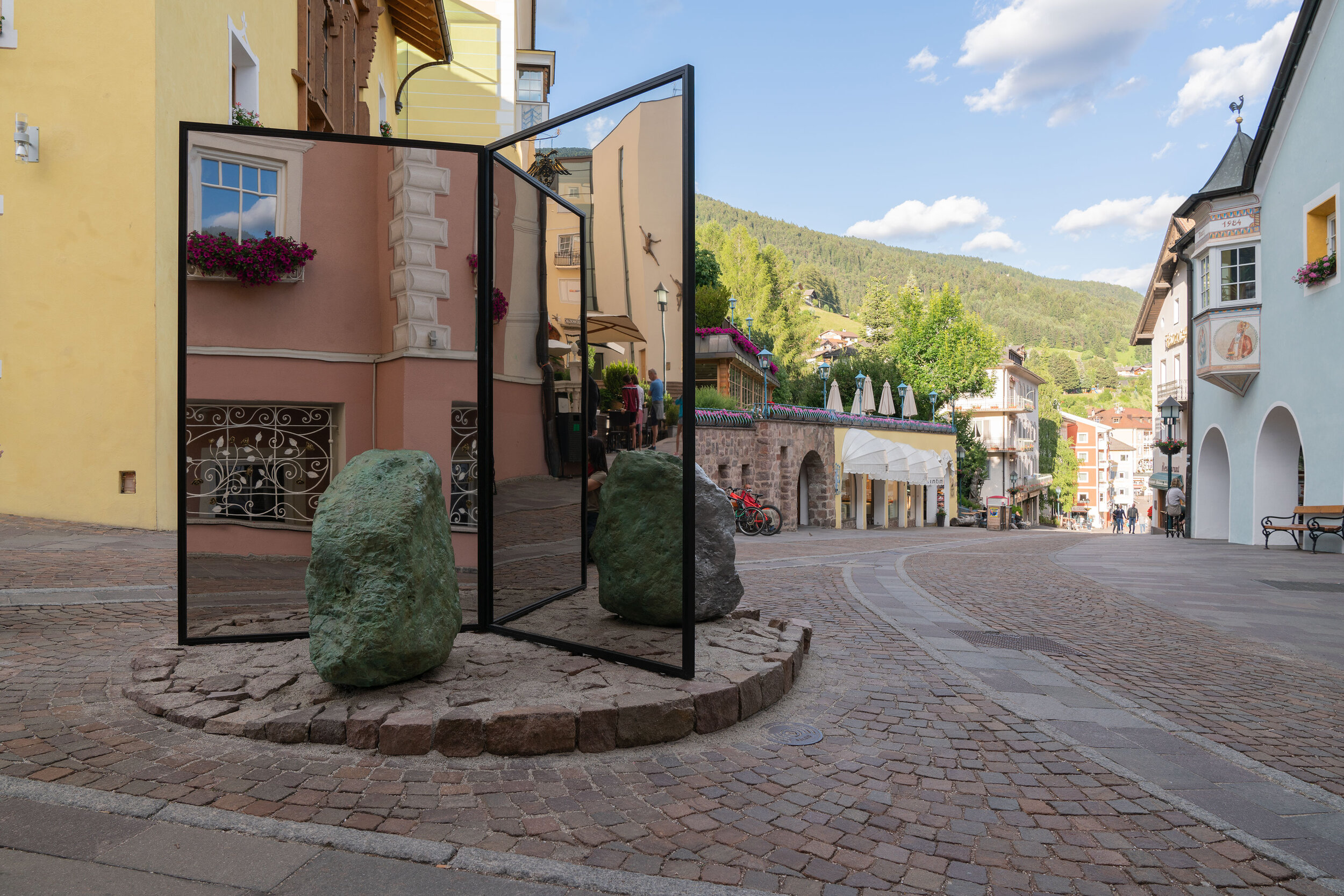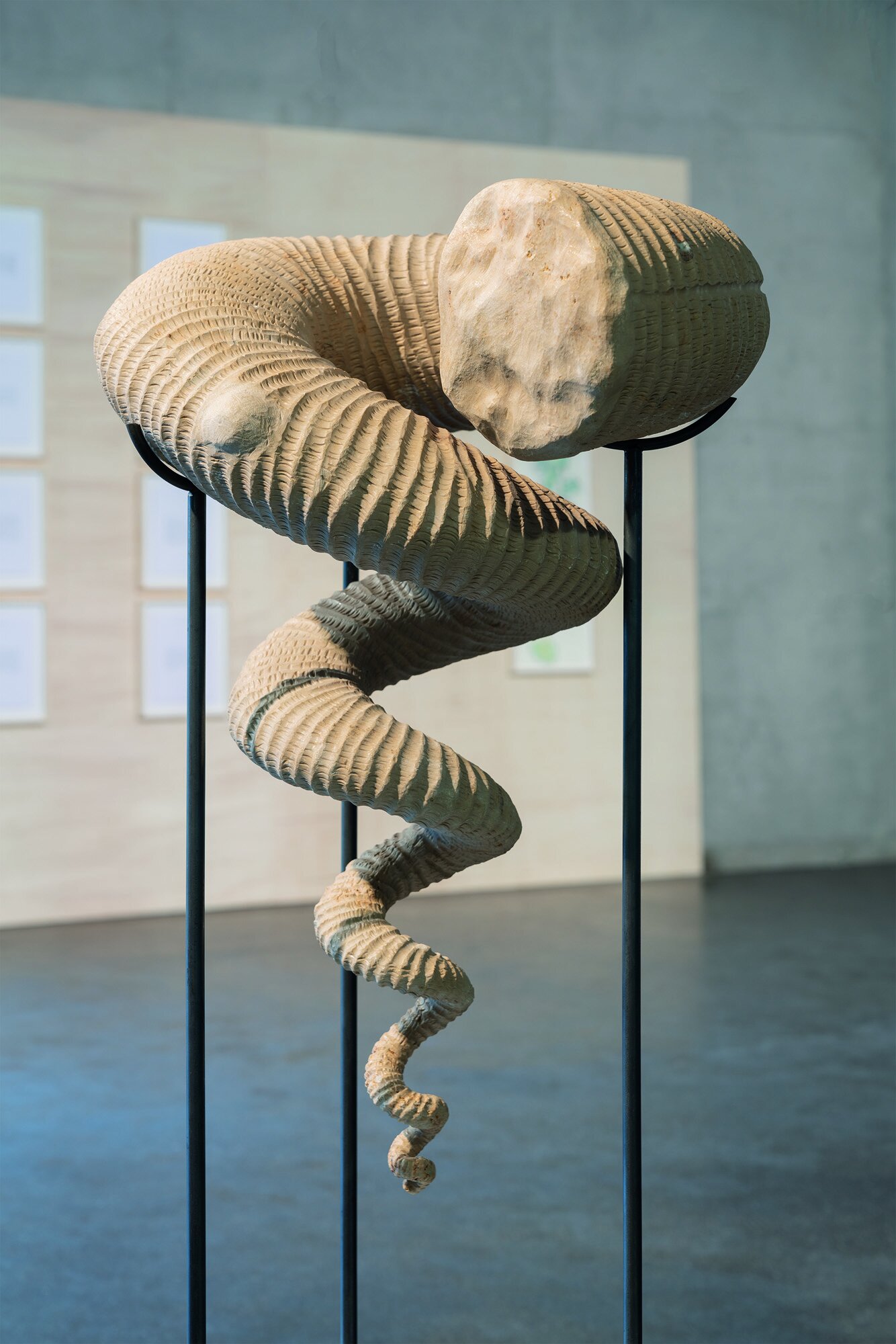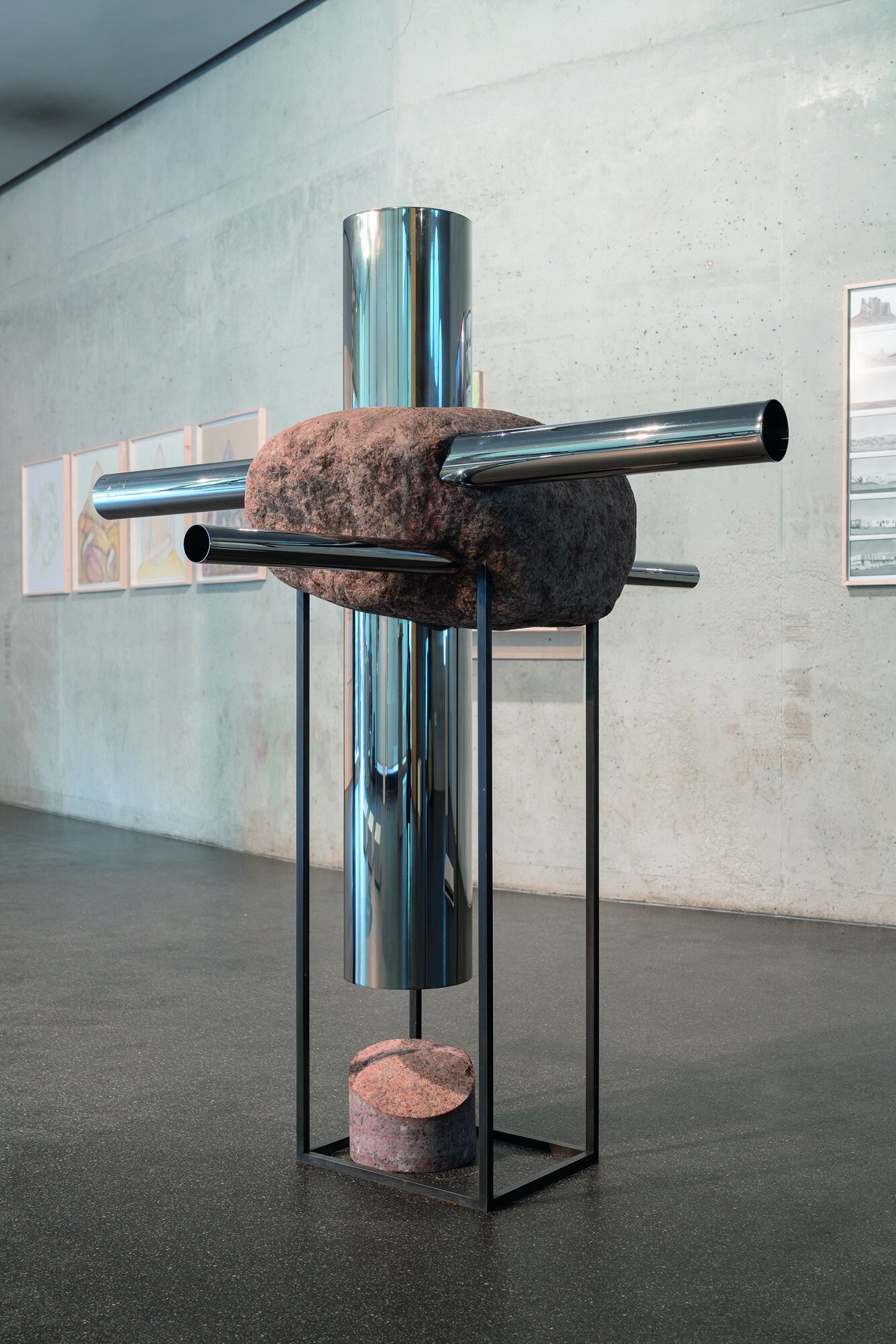
Alicja Kwade
*1979, Poland
lives and works in Berlin, Germany
EN
“I’m trying to see what the structure of reality could be,” explains Alicja Kwade while she practices her sculptural poetry and explores the lyrical fetishisms of materials. Her sculptures are meditations on time, space and the nature of objects. She engages with the question of what constitutes the “truth” and “time” of an object, and whether this can be equated with the information that describes it. Materials such as stone, glass and wood are transformed in her sculptural arrangement via elaborate, alchemical operations. Through these physical shifts, Kwade proposes new meaning and value.
Kwade’s new work, Absorption (Dolomite), conceived especially for the Biennale Gherdëina VI and displayed at the crossway of the pedestrian zone, appropriates original Dolomite stone and invites it into a series of transformations through scanning and duplication. The artist engages the viewer in a vertiginous interplay of perception as the walls of the mirror expand space and reflect the surrounding area, literally absorbing it, as the title suggests. Thus Kwade theatricalizes nature and the human being’s participation in it, creating a situation of sensual and cognitive tension.
Her sculpture Taxa-Dilation on view in Circolo artistico e culturale exemplifies a complexity of transformative processes the artist is interested in. For this work, Alicja Kwade scanned an original, approximately 200-million-year-old fossilized ammonite from the collection of Berlin’s Museum of Natural History. The ammonite’s spiral was then digitally separated and manipulated into four new forms – a series of three spiral forms unfolding in three stages and one straightened-out – whose cores were then physically built. Taxa, in biological terms, describes a unity of classification attributed to a group of living organisms according to a set of particularly defined criteria. This classification usually expresses itself by designating a name to this group. The title of the work refers to two of its aspects; it describes both a diversification of types and a more formal process of expansion and dissolution. In the work, a temporal process is captured and itself fossilized; the spirals’ three stages are conceived as a movement, and can be theorized as fossilized forms showing three stages of the evolution of a living organism in its journey to becoming a new species, a process which affects us all.
IT
“Mi interessa comprendere la struttura della realtà” spiega Alicja Kwade durante una sua performance di poesia sculturale, alla ricerca del feticismo lirico proprio dei materiali stessi. Le sue sculture costituiscono delle riflessioni sul tempo, sullo spazio e sulla natura degli oggetti. L’artista si interroga su quale sia l’aspetto reale e temporale di un manufatto, e se quest’ultimo possa essere paragonato alle informazioni utili per descriverlo. Materiali comuni, come pietre, vetro e legno trovano una collocazione nei suoi assemblaggi scultorei dopo complesse operazioni. È per mezzo di tali cambiamenti che Kwade propone nuovi significati e valori.
Il nuovo lavoro della Kwade, Absorption (Dolomite), è invece concepito appositamente per la Biennale Gherdëina VI, e allestito ad un incrocio della zona pedonale; per questo lavoro l’artista fa uso della pietra dolomia, a sua volta sottoposta a svariate trasformazioni per mezzo di operazioni di digitalizzazione e duplicazione. Il fruitore è coinvolto in un gioco di percezioni vertiginose, nel momento in cui gli specchi espandono lo spazio e riflettono il contesto circostante, assorbendolo letteralmente, come suggerisce il titolo…
In tal modo Kwade mette in scena il mondo naturale e la partecipazione ad esso dell’essere umano, creando una situazione di tensione sensuale e cognitiva.
La sua scultura Taxa-Dilation, in mostra al Circolo artistico e culturale per la Biennale Gherdëina VI, è un chiaro esempio della complessità delle trasformazioni da cui l’artista è affascinata. Per questo lavoro, Alicja Kwade ha riprodotto digitalmente un fossile di ammonite di circa 200 milioni di anni, appartenente alla collezione del Museo di Storia Naturale di Berlino. La spirale dell’ammonite è stata poi estratta digitalmente e manipolata in quattro nuove forme - una serie di tre spirali aperte in stadi diversi, ed una completamente srotolata - di cui l’artista ha ricostruito fisicamente gli elementi essenziali. Nelle scienze naturali il termine Taxa costituisce un’unità di classificazione attribuita ad un insieme di organismi viventi, raggruppati secondo criteri particolarmente definiti. Questa classificazione normalmente viene espressa per mezzo di un nome che contraddistingue il gruppo. Il titolo dell’opera ha perciò un duplice significato, alludendo da un lato alla diversificazione delle specie e dall’altra ad un processo di espansione e dissoluzione. L’opera mette in evidenza un processo temporale, fossilizzato su se stesso; i tre stadi della spirale sono concepiti come un movimento, e possono essere visti come forme fossili che mostrano tre diversi livelli dell’evoluzione di un organismo vivente, nel suo viaggio per diventare una specie nuova attraverso un processo che ci contraddistingue tutti.
DE
„Ich versuche zu verstehen, welche Struktur die Realität hat“, erklärt Alicja Kwade, während sie eine Poesie des Skulpturalen praktiziert, und die lyrische Magie von Materialien untersucht. Kwades Skulpturen sind Meditationen über Zeit, Raum, und die Natur von Objekten. Die Künstlerin beschäftigt sich mit der Frage, was die „Wahrheit“ und „Zeit“ eines Objektes ausmacht, und inwiefern diese übereinstimmen mit der Beschreibung eines Objektes. Alltägliche Materialien so wie Stein, Glas, Holz, werden anhand von Prozessen in minimalistische Arrangements transformiert. Durch diese Veränderungen erlangen die Werke von Kwade neue Bedeutungsebenen.
Kwade’s neue Arbeit Absorption (Dolomite), welche eigens für die Biennale Gherdëina VI konzipiert und realisiert wurde, und in der Fußgängerzone von St. Ulrich installiert ist, verwendet einen originalen Dolomit-Stein und transformiert diesen vielfach anhand von Prozessen des Scannens und des Vervielfältigens. Die Künstlerin konfrontiert den Betrachter in einem schwindelerregenden Spiel von Wahrnehmung, indem sie Spiegelflächen installiert, die den Raum erweitern und die Umgebung reflektieren, oder – wie der Titel andeutet – sprichwörtlich absorbieren. So wird die Natur und der in ihr handelnde Mensch zu einem Akteur, in einem spannungsgeladenen Spiel zwischen sinnlicher und kognitiver Wahrnehmung.
Ihre Skulptur Taxa-Dilation, welche im Kreis für Kunst und Kultur zu sehen ist, ist exemplarisch für die Komplexität der transformatorischen Prozesse, für die sich die Künstlerin interessiert. Für diese Arbeit scannte Alicja Kwade einen vermutlich 200 Millionen Jahre alten versteinerten, spiralförmigen Ammoniten aus der Sammlung des Berliner Naturhistorischen Museums. Die Spiralform wurde dann digital zerschnitten und zu vier neuen Formen zusammengestellt, deren Gehäuse dann nachgebaut wurden. Dabei entstand eine Serie von drei Spiralformen, welche sich in drei verschiedenen Stadien entfalten, und eine vierte Form wurde begradigt. Taxa beschreibt in der Biologie eine Einheit, welche eine Gruppe lebender Organismen anhand von bestimmten Kriterien beschreibt und zuordnet. Der Titel dieses Werkes bezieht sich auf zwei dieser Kriterien; er beschreibt sowohl eine Diversifizierung von Typen, sowie einen formaleren Vorgang von Expansion und Auflösung. In dieser Arbeit ist der in der Zeit stattfindende Veränderungsprozess dieses Organismus in versteinerter Form festgehalten. Die drei Stadien der Spirale sind als Bewegung konzipiert, und können als fossile Formen beschrieben werden, welche drei unterschiedliche Stadien der Evolution eines lebenden Organismus auf seiner Reise hin zu einer neuen Spezies darstellen, ein Prozess, welcher uns alle betrifft.



